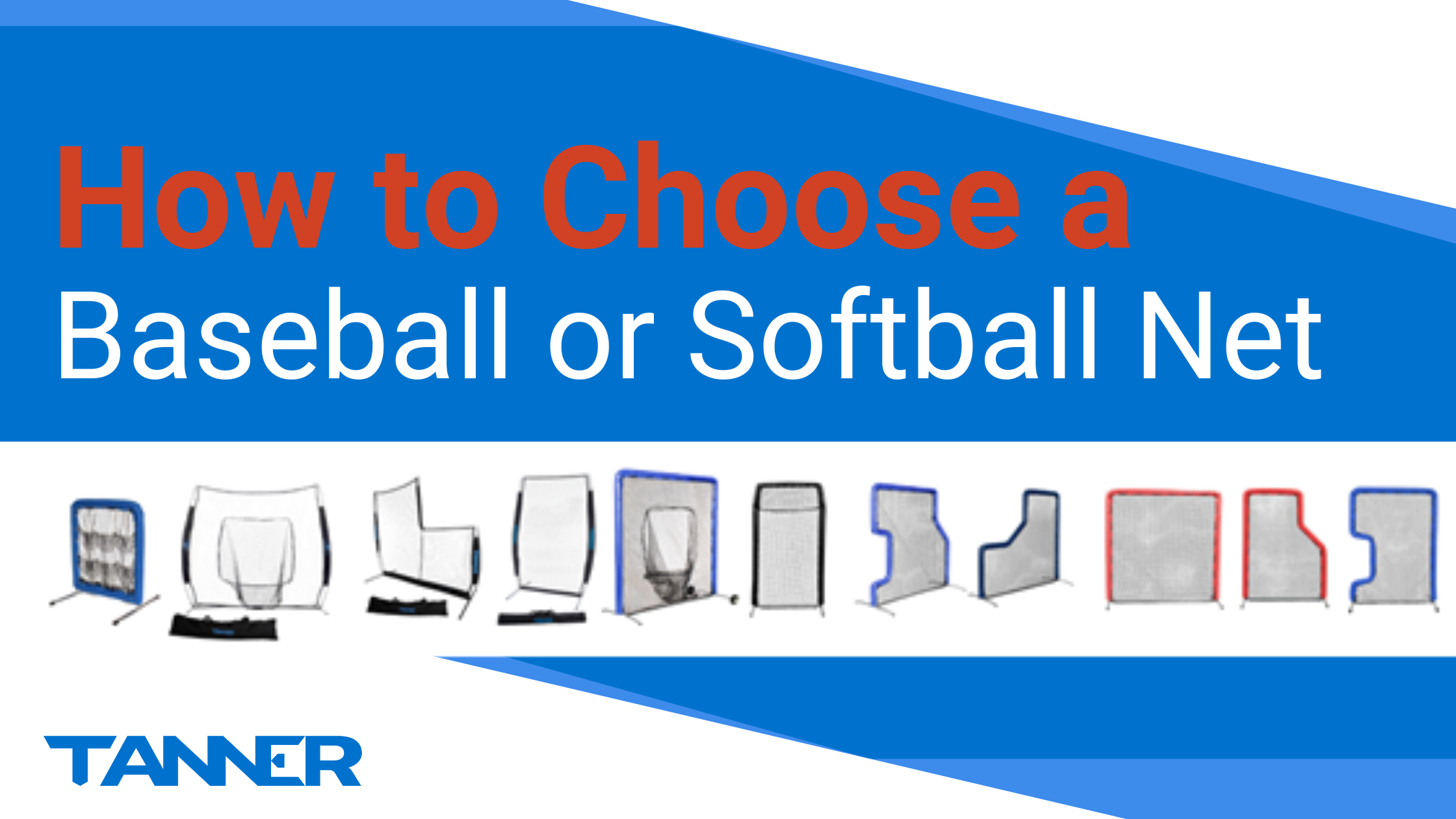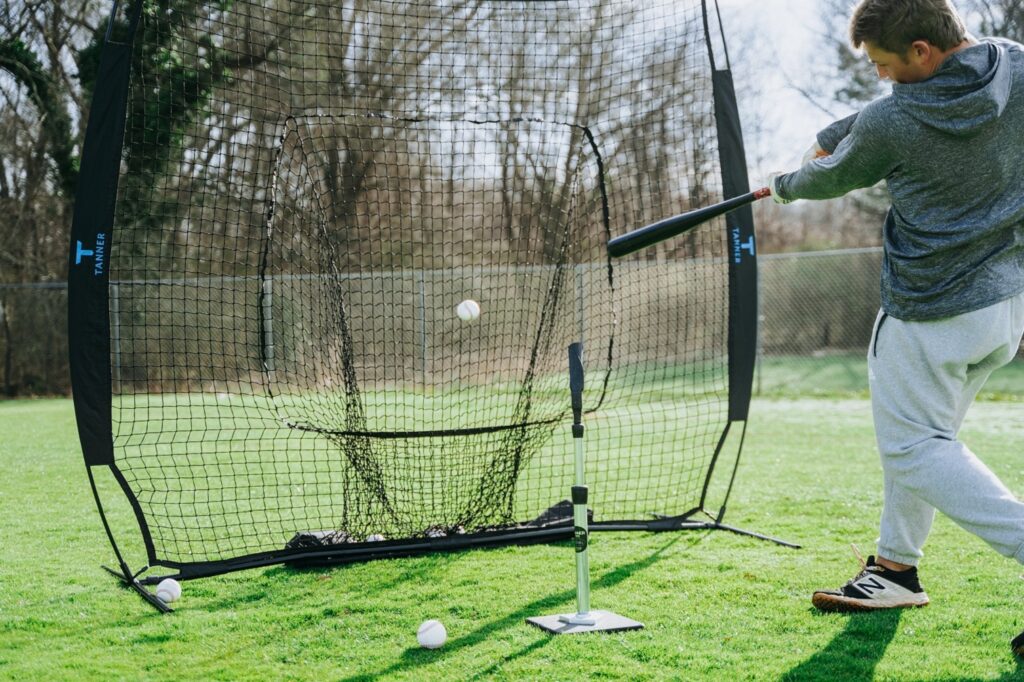Search Articles
Guide to the 4 Most Popular Types of Softball and Baseball Nets

Est. Reading:
7 min
Updated: September 19, 2023
Article Contents
In this post, we’ll break down the most popular types of softball and baseball nets. We’ll cover when to use each of them, along with everything else you need to know so you can choose which net is best for you.
Here are the 4 most popular types of softball and baseball screens and nets:
- Hitting Nets
- Throwing Nets
- Pitching Nets (Such as L Screens, I Screens, and Front Toss screens)
- On-Field Safety Screens
Hitting Nets
First things first. Don’t be confused by the name.
While "softball hitting net" or “baseball hitting net” is the most common thing people call them, these nets are frequently called by many different names, such as:
- Hitting nets
- Batting nets
- Throwing nets
- Pitching nets
They are basically just large nets that you can hit or throw into. The most important thing is that these nets will deaden the ball and prevent ricochet.
What Hitting Net Should I Get?
By far, the most popular type of net in this category is a sock net.
But when you’re making the decision of which softball or baseball-hitting sock net to buy, you’ll first need to consider the 2 main categories:
Portable or “Pop Up” Hitting Nets
For most parents and youth coaches, this will be their go-to option.
The Travel Hitting Net is often the best choice for anyone who wants to:
- Use the hitting net at home (garage, yard, driveway, basement, etc.)
- Take it to a local public field for individual or team practice
The most popular size is 7 feet by 7 feet, so hitting nets can certainly take up a lot of space.
That’s why the travel-style nets are so popular. Typically, they are stored in a carrying bag and usually can be assembled in just a few minutes.
Then when practice is finished, they can be disassembled even faster and thrown into a car or stored easily away at home.
If you’re looking for a travel-friendly sock net for hitting or throwing, check out the Tanner Flex Frame Portable Batting Net with Carrying Bag

- The Tanner Batting Net / Hitting Net is 7 feet by 7 feet in size.
- It has a flexible frame and a sock-like design to catch balls during practice.
- The net is portable and easy to set up at home, in the backyard, or in the field.
- It's suitable for practicing hitting and throwing baseballs, softballs, and teeballs.
- The net comes with a carrying bag that has a carry strap.
Heavy Duty, Commercial-Grade Hitting Nets
If you have a dedicated space for baseball or softball training - and therefore no need to travel with the net or break it down and put it away - then this might be the net for you. Or if you need a hitting net designed for frequent use by a team or in a commercial hitting facility, this may be the batting net you want.
These nets are made from highly durable materials and are often weather-resistant.
This option is usually best for:
- Team facilities such as high school, college, or professional teams
- Commercial baseball/softball batting cages
- Outdoor personal practice areas
One of the best commercial grade nets in this category is Bullet 7' x 7' Commercial Batting Net with Sock
This Bullet 7' x 7' Batting Net with socknet was specifically designed for training within confined spaces. The 4’ deep socknet keeps the balls in one place to reduce pick-up time and maximize reps!
- Durable and rust-resistant 7’H x 7’W frame with socknet
- 14 gauge galvanized steel frame
- #60 UV-treated poly, double-layer netting
- Optional - Heavy duty 18 oz vinyl and 1.5" impact foam padding
- Optional Wheels for easy transport
- All-weather materials provide protection from outdoor elements
Throwing Nets
Unlike the category of “hitting nets” which can be used for either hitting or throwing, there are some nets which are designed just for throwing into.
By far the most popular example of this type of baseball nets for throwing is the 9 Hole Pitcher’s Pocket.
A 9-hole pitcher's pocket net is a training tool used by pitchers in baseball and softball to help improve their accuracy and consistency in throwing the ball into specific areas of the strike zone.
It is a net with nine different pockets, each representing a different location in the strike zone where the pitcher should aim to throw the ball. These pockets are labeled with numbers and correspond to the different zones of the strike zone. The pitcher aims to hit the pockets consistently to improve their accuracy.
The net is typically hung behind a home plate, and the pitcher throws from a designated pitching distance. As the pitcher throws the ball, it hits the net, and the ball falls into one of the nine pockets, indicating where the ball would have landed in the strike zone.
Using a 9-hole pitcher's pocket net is a popular and effective way for pitchers to train their accuracy, consistency, and control of their pitches. It allows pitchers to practice hitting specific locations in the strike zone, which is crucial for success in baseball and softball.
NOTE: These throwing nets are not JUST for pitchers!
The Pitcher’s Pocket throwing nets are also great to use for infielders, outfielders, and catchers. In other words, anyone who needs to practice throwing accurately can benefit from these.
Pitching Nets
This category of baseball nets includes:
- L Screen Nets
- I Screen Nets
- Front Toss Screens
- Combo Nets
- General Safety Screens
L Screens for Baseball & Softball
By far, the most recognizable of these safety nets is the L screen.
What is an L Screen Net?
An L-screen for baseball and softball is a protective screen that is used to shield a pitcher during batting practice or in a game situation. It is named after its L-shaped design, which provides a protective barrier for the pitcher while still allowing them to pitch the ball. It is an essential piece of safety equipment to prevent injury.
The L-screen net typically consists of a metal frame with a net or other type of protective material attached to it. The screen is placed in front of the pitcher and angled in such a way that it protects them from line drives or other hard-hit balls that may be hit back up the middle or off to the side.
The L-screen is an essential safety tool for baseball pitchers, especially during batting practice, when balls are being hit directly back at them.
It allows pitchers to focus on their pitching without worrying about getting hit by a line drive or other type of hard-hit ball. It can also be used in game situations, such as when a pitcher is recovering from an injury or is facing a particularly hard-hitting opponent.
Overall, L screen nets are an important piece of equipment for baseball pitchers and coaches, as they help keep them safe while they are practicing or playing the game.
What is an L screen used for?
The L Screen is used for protection when throwing overhand batting practice. If you’re throwing underhand front toss, then you’ll flip it around to use the taller straight side.
What is the difference between an L screen and I screen?
The main difference between L screens and I screens is the type of throwing they are meant for.
- L screens can be used for baseball or softball pitching, and for overhand or underhand throwing
- I screens are only meant for underhand flips (aka front toss) or softball pitchers
I Screen Nets
Like the L Screen, an I Screen Net is a piece of protective equipment that is positioned in front of the pitcher during batting practice to protect them from line drives hit back up the middle. This type of pitching net is used for underhand flips or softball style pitching.
Front Toss / Hybrid Pitching Nets
The classic L screen and I screen have been adjusted in clever ways to get more out of them.
For example, the line of bullet nets includes some that are specifically for front toss (aka underhand flips). So rather than having to duck behind an i screen, the pitcher has a cutout that allows the ball to pass through but still offers protection for the head and legs. Two examples of this are the Bullet Commercial 7' x 5' Front Toss Screen Pitching Net with Cutout and the Bullet Commercial 7' x 7' L Screen Pitching Net Combo.
On-Field Protective Screens
Besides the pitcher, there are often other reasons to need protection on the field … such as when 1st base or outfield are doing drills during batting practice.
Using nets in baseball and softball can be an effective way to improve safety during training and practice. Here are a few ways that nets can enhance safety in baseball:
- They can prevent errant balls from flying out of the practice area and potentially injuring people or damaging property.
- They can provide a designated space for batters and pitchers to practice without worrying about disrupting other activities.
- They can reduce the risk of players getting hit by a ball during batting practice
- They can help protect the longevity of your netting and other equipment, as heavy-duty padding can reduce ball ricochet and minimize wear and tear.
Overall, using nets is a smart way to promote safety in baseball and ensure that everyone involved can train and practice with peace of mind.
To keep baseball and softball players safe from being injured by line drives, coaches use large square screens like the Bullet 7' x 7' Commercial Pitching Net / Protective Screen


